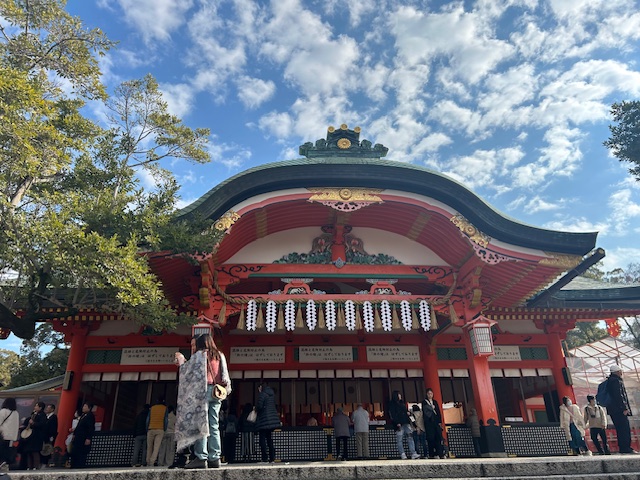With a slowing down of our journey speed on this half of the trip we were grateful to have 9 days in Kyoto. Our first day we visited Gion an area known for its traditional wooden houses, narrow laneways, the Yasaka shrine and Kenninji Temple. This is also known as the Geisha district, taking part in kimonos rental with makeovers, they were dressed up, some wandering the cobbled streets in the rented wooden sandals, taking Instagram photos. There are areas of Gion where photos are not allowed, which makes sense. We were luck and did see a real geisha riding in the back of a taxicab, they are not to be photographed. I enjoyed re-watching the movie Memoirs of a Geisha.
One of our favourite districts in Kyoto was Arashiyama, on the far western outskirts of the city. Crossing the recognizable Togetsukyo Bridge, wandering in the Bamboo Grove, and the Okochi Sanso traditional Japanese Gardens was a delightful way to spend the afternoon. We enjoyed visiting the monkey park at Iwatayama, hiking up for great views of the city and fun interactions with the snow monkeys, a type of macaw monkeys, found in the Japanese mountains. The Arashiyama area was home to several shrines and temples as well as many food vendors and interesting shops.
Our Airbnb was located very close to the Fushimi Inari Shrine, a famous Shinto shrine known for its thousand Torii gates. It is one of the busiest tourist destinations in Kyoto and we were grateful to be staying close to, arriving relatively early in the day to avoid the heavy crowds. A beautiful trail leads you through a forest to the sacred Mount Inari. Inari is the Shinto God of rice and fox is thought to be her messenger. As you walk in the shrine there is a steep ascending hill to the final temple and look out. There are many temples, Torri gates and fox statues below the final lookout and thus it becomes less crowded as many people are not interested in the hike. It is hard to describe the amazing experience of travelling through the Torii gates passageway, surrounded by beautiful forest.
Our family also enjoyed visiting the Manga Museum. There were 1000 pictures of Maiko (geisha apprentices) drawn by different professional manga artists, Mangaka. There was an extensive manga library with over 5000 books, most in Japanese. There was a well-done exhibit on the history of Manga in Japan, its growing popularity and spread throughout the world. Aiden particularly enjoyed the exhibit on old video games, the kids were both impressed by how well their dad played space invaders.
I explored the Kyoto Botanical Garden and Kinkakui, the Golden Pavilion and its surrounding beautiful garden. This was a built as a retirement villa for a shogun, who bequeathed it as a Zen Temple after his death in 1408. The Botanical Garden was amazing, despite the winter season. I enjoyed watching many different types of birds enjoying the blossoms that still survive. The Japanese bridges, water wheels and small waterfalls give a wonderful sense of tranquility. The indoor conservatory was incredible, again amazing blossoms, particularly the water lilies and the orchids. I had the joy of meeting a school group, likely age 6 or 7, they were so quiet and respectful, clearly enjoying and valuing the connection with nature that the conservatory offered. I hope to visit Japan in other seasons, the Japanese respect and love for nature, the cycle of impermanence and the metaphors for life.
Meanwhile Alastair, Sophie and Aiden attended Ninja classes. They dressed in Ninja outfits, learned Ninja walking, breathing, and weaponry. They were excited to tell me all about using Swords, Kuna Knives, Shirken (throwing stars), Blow guns and throwing a knife on a rope. They enjoyed the secret doors in the Ninja studio and came back enthusiastic and full of confidence about their skills. Unfortunately, Aiden’s search for a Katana, has not been as easy as we had hoped. The swords used for training in the martial arts cannot be sharpened and Aiden feels determined that if he is buying a sword, it must have the ability to cut vegetables and wood. Other swords are antique or display swords, thus fiercely expensive.













































